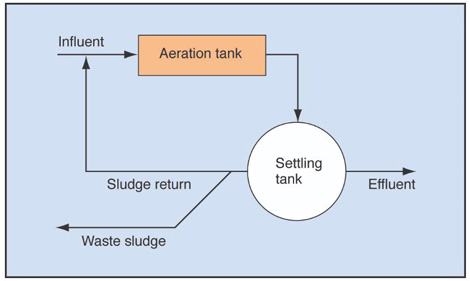

Wastewater Treatment Components and Functions

Wastewater Treatment is a complex process composed of smaller individual processes that all add up to produce a high-quality effluent. That effluent is then discharged into the waterways that you and I use. In general, the wastewater treatment process is broken into three phases or stages of treatment, primary, secondary, and tertiary treatment. Each one of these stages has a specific role to play in the overall treatment process. To keep this article short, we will take the 30,000-foot view of each. We will discuss what happens during each process and how it is achieved.
Primary Treatment
Primary treatment involves the physical process of sedimentation. In sedimentation, heavier solids fall out of suspension and are removed from the waste stream. Floating material is also removed from the process leaving only suspended solids to continue through the treatment process. Primary treatment is typically done in a primary clarifier, a large tank or basin designed to slow the flow and allow solids to settle. The solids that float in the primary clarifier are skimmed from the surface and disposed of. This primary step removes 80% of the solids coming into a wastewater treatment plant. Some also group preliminary treatment activities in this category as well. Preliminary treatment includes screening inorganic material out of the waste stream and removing sand or grit. Bar screens catch large material before it reaches the plant and grit is removed by centrifugal force in a grit cyclone or allowed to settle out. This happens fast as there is not much detention time needed for sedimentation and screening to occur when compared to the biological portion of treatment.
Secondary Treatment
Once wastewater passes through primary treatment, it goes through the secondary treatment stage. Secondary treatment is the stage where biological processes remove the nutrients in the waste stream. Through a series of aerobic and anaerobic processes, the microorganisms or ‘bugs” break down and consume ammonia and phosphorus. This stage of treatment occurs in oxidation ditches while other plants employ the activated sludge process. Secondary treatment takes longer than primary treatment as the microorganisms need more time to break down the organic material. This step also involves a secondary clarifier that once again slows the flow down and allows the solids and microorganisms to settle out and either be returned to the treatment process or wasted out of the system.
Tertiary Treatment
Tertiary is the last stage of the wastewater treatment process and involves filtering and disinfection. The remaining solids, which may be microscopic at this point, are removed through filtration. The filters could be rotating disc filters or sand filters. Once the water has been filtered it heads to disinfection. Disinfection is achieved by either ultraviolet light or chlorination. Both methods destroy pathogenic organisms such as bacteria and viruses.
Again, this is an extremely basic overview of the wastewater treatment process. There are many complex processes and mechanisms that we could go much more in depth on. The more in-depth material is what you will cover in your operator certification classes and continuing education courses. For today, just think of primary, secondary, and tertiary treatment. Primary treatment removes the bulk of the solids, secondary treatment breaks down the nutrients and returns the bugs to the treatment process, and tertiary treatment cleans up any leftover particles and disinfects against harmful viruses and bacteria.